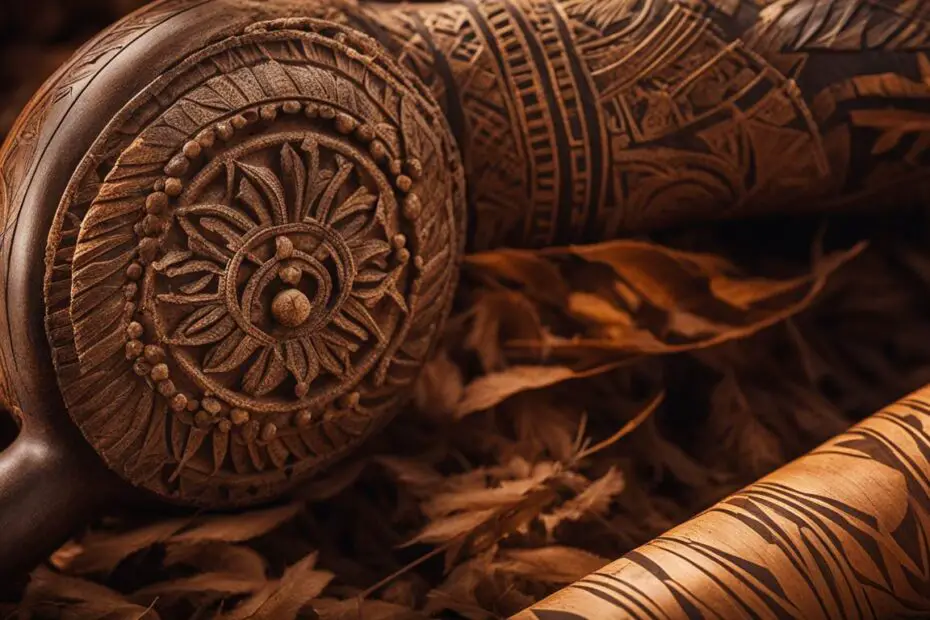The Sacred Pipe, also known as the Chanunpa, holds great significance in the culture of Native American tribes. It is considered a spiritual artifact and a religious altar, to be treated with respect and care. The pipe is used in sacred rituals and spiritual practices, serving as a medium for prayer and communication with the divine. The smoke from the pipe symbolizes the truth being spoken and the plumes of smoke create a pathway for prayers to reach the Great Spirit. Different tribes may have variations in their use of the pipe, and the materials used for its construction may vary as well.
Key Takeaways:
- The Sacred Pipe, or Chanunpa, is an important spiritual artifact in Native American culture.
- It is used in sacred rituals and serves as a medium for prayer and communication with the divine.
- The smoke from the pipe symbolizes truth and creates a pathway for prayers to reach the Great Spirit.
- There are variations in the use of the pipe among different tribes and the materials used for its construction may vary.
- The Sacred Pipe is a powerful symbol of Native American spirituality and cultural heritage.
The Role of the Sacred Pipe in Native American Culture
The sacred pipe holds a central role in Native American culture and traditions, particularly in the practice of ceremonial smoking. Used by various tribes, the sacred pipe is loaded with sacred tobacco and smoked as a form of prayer and offering to the spirits. Among the Lakota Sioux tribe, the sacred pipe, known as the chanunpa, is considered a sacred instrument of communication with the divine. Smoking the pipe is seen as a way to connect with the spiritual realm and seek guidance from the Great Spirit.
The act of smoking the sacred pipe carries deep symbolism. It is believed that the smoke from the pipe carries prayers and messages to the Great Spirit, establishing a direct line of communication between humans and the divine. The tobacco used in the pipe is considered sacred and its cultivation and preparation were the responsibility of the Tobacco Society within the tribe. Smoking the pipe is seen as an act of offering prayers and seeking spiritual guidance.
While the use of the sacred pipe is widespread among Native American tribes, there may be variations in its practice and significance among different sects. Each tribe may have its own unique ceremonial practices and rituals associated with the sacred pipe. Additionally, the materials used for the construction of the pipe can vary, with pipes made from wood, stone, clay, or animal bone. The choice of materials is made based on their strength, durability, and spiritual significance.
| Tribes | Materials Used |
|---|---|
| Lakota Sioux | Pipestone, Wood, Bone |
| Cherokee | Wood, Stone |
| Apache | Clay, Wood |
Over time, the sacred pipe has evolved and adapted to reflect the changing circumstances and influences faced by Native American tribes. Changes in materials and construction techniques have occurred, reflecting the availability of resources and the influence of outside cultures. However, despite these variations, the sacred pipe continues to hold a central place in Native American spirituality and traditions, serving as a powerful tool for prayer, communication, and spiritual connection to the divine.
Symbolism of the Sacred Pipe
The sacred pipe holds deep symbolism for Native American tribes. It represents a spiritual connection to the divine and serves as a powerful prayer tool. The act of smoking the pipe is seen as a sacred ritual, signifying the offering of prayers and seeking spiritual guidance. The smoke that rises from the pipe is believed to carry these prayers and messages to the Great Spirit, creating a direct line of communication between humans and the celestial realm.
“The sacred pipe is a pathway for our prayers to travel to the Great Spirit. It is a physical embodiment of our spiritual connection and reverence for the divine,” explains Chief Thunder Eagle of the Lakota Sioux tribe.
The symbolic meaning of the sacred pipe goes beyond its physical form. It signifies unity and harmony among tribal members and serves as a reminder of their shared spiritual heritage. The pipe itself is considered a sacred object, reflecting the sacredness of the land and the natural world. It represents the interconnectedness of all living beings and the importance of maintaining balance and respect for Mother Earth.
The Significance of the Four Directions
Within the symbolism of the sacred pipe, the four directions play a vital role. Each direction – north, south, east, and west – represents different aspects of life, such as wisdom, strength, love, and spirituality. When the pipe is smoked, it is held up to each direction in a clockwise manner, honoring the sacredness and guidance associated with each direction. This ritual reinforces the spiritual connection and seeks blessings from all aspects of creation.
| Direction | Symbolic Meaning |
|---|---|
| North | Wisdom, introspection, and winter |
| South | Renewal, growth, and summer |
| East | New beginnings, the rising sun, and spring |
| West | Introspection, reflection, and autumn |
The symbolism of the sacred pipe signifies the deep spiritual connection between Native American tribes and the natural world. It serves as a prayer tool, a representation of unity, and a constant reminder of the sacredness of life and the interconnectedness of all beings. Through the act of smoking the pipe, Native Americans seek spiritual guidance and foster a sense of harmony and balance within themselves and the world around them.
Variations and Evolution of Prayer Tools in Native American Culture
Native American tribes have a rich tradition of using various prayer tools in their spiritual practices. These tools hold deep symbolic meaning and have evolved over time, reflecting the diverse cultural and geographical influences among different sects.
Sacred Pipe
The sacred pipe, or Chanunpa, is perhaps the most well-known prayer tool in Native American culture. However, there are variations in its design and usage among different tribes. For example, the Lakota Sioux tribe has a distinct ceremonial smoking tradition associated with the sacred pipe, using it as a medium for prayer and communication with the divine.
Feathers and Drums
Feathers and drums are also commonly used in Native American rituals. Feathers hold significant symbolic meaning, representing spiritual connection and communication. Different feathers may be used for specific purposes, such as eagle feathers for strength and wisdom. Drums serve as powerful instruments for creating rhythmic vibrations that connect with the spiritual realm. They are used in ceremonies to invoke spiritual energy and facilitate prayer.
Sacred Herbs
Sacred herbs, such as sage and sweetgrass, play an integral role in Native American ceremonies and rituals. These herbs are burned as incense to purify the space and create a sacred atmosphere. The smoke from burning sacred herbs is believed to carry prayers to the divine and purify the mind, body, and spirit.
| Prayer Tools | Usage | Symbolism |
|---|---|---|
| Sacred Pipe | Used in ceremonial smoking for prayer and communication with the divine | Represents a spiritual connection and offering of prayers |
| Feathers | Used to represent spiritual connection and communication | Symbolizes strength, wisdom, and the ability to soar above earthly concerns |
| Drums | Used to create rhythmic vibrations and connect with the spiritual realm | Symbolizes the heartbeat of Mother Earth and the power of sound |
| Sacred Herbs | Burned as incense for purification and creation of a sacred atmosphere | Symbolizes cleansing, healing, and the offering of prayers |
Over time, prayer tools and their usage have changed to adapt to new circumstances and influences. The availability of resources, contact with other cultures, and the impact of colonization have all contributed to the evolution of these tools. Despite these changes, the core symbolism and spiritual significance of these prayer tools remain deeply rooted in Native American culture.
Materials Used for the Sacred Pipe
The construction of the sacred pipe involves the use of traditional materials that hold spiritual significance for Native American tribes. These materials are chosen for their strength, durability, and sacred qualities. The main components of the pipe include the bowl, stem, and mouthpiece, each crafted with specific materials.
Materials
The bowl of the sacred pipe is typically made from stone, most commonly catlinite, also known as pipestone. Catlinite holds deep ceremonial and spiritual significance and is considered sacred by many tribes. The stem of the pipe is often made from wood or hollowed-out bone, symbolizing the connection between the earthly realm and the spiritual realm. The mouthpiece, which is used for inhaling and exhaling the smoke, is traditionally made from bone or a combination of bone and wood.
Construction Techniques
The construction process of the sacred pipe requires intricate craftsmanship and attention to detail. The stone for the bowl is carefully carved and shaped to create a smooth and functional cavity. The stem is crafted with precision, ensuring a comfortable grip and proper airflow. The mouthpiece is delicately carved and shaped to allow for a secure and comfortable fit. Traditional construction techniques have been passed down through generations, preserving the authenticity and sacredness of the pipe.
| Component | Traditional Materials |
|---|---|
| Bowl | Stone (Catlinite) |
| Stem | Wood or Hollowed-out Bone |
| Mouthpiece | Bone or Combination of Bone and Wood |
The materials used for constructing the sacred pipe may differ among tribes and regions, reflecting the cultural diversity and ancestral beliefs of each group. However, the fundamental significance of these materials in connecting with the spiritual realm remains consistent.
Lesser-Known Sacred Prayer Tools
In addition to the sacred pipe, Native American cultures have various other prayer tools and spiritual instruments that hold deep significance. These tools serve as conduits for spiritual connection, ritual, and cultural expression. Let’s explore some of these lesser-known sacred prayer tools and their cultural significance.
Feathers
Feathers play an important role in Native American rituals and ceremonies. They are seen as symbols of spiritual connection and communication, representing the ability to soar to greater heights and connect with the divine. Feathers are often used in smudging ceremonies, where the smoke created by burning sacred herbs is fanned with a feather to purify and cleanse the space. They may also be incorporated into elaborate headdresses and regalia worn during ceremonial dances and celebrations. Each feather holds its own unique meaning and significance, depending on the bird it comes from and the tribe’s specific traditions.
Drums and Rattles
Drums and rattles are powerful instruments used in Native American rituals and ceremonies. The rhythmic beats of the drum and the shaking of rattles create vibrations that are believed to connect with the spiritual realm and awaken the senses. These instruments are used to set the rhythm and energy during dances and ceremonies, allowing participants to enter a trance-like state and commune with the divine. The drumbeat symbolizes the heartbeat of Mother Earth, while the rattling sound represents the transformative power of sound and vibration. The materials used to construct drums and rattles vary among tribes, with animal skins, wood, and natural fibers being commonly utilized.
Sacred Herbs
Sacred herbs are fundamental to Native American spiritual practices and ceremonies. Sage, sweetgrass, cedar, and tobacco are among the herbs widely used for purification, healing, and spiritual connection. Sage is burned to cleanse and purify both individuals and spaces, while sweetgrass is used to invite positive energy and blessings. Cedar is considered a sacred herb that helps to dispel negative influences and promote spiritual balance. Tobacco, often used in combination with the sacred pipe, is seen as a sacred offering and a way to communicate with the spirits. The burning of these herbs and the release of their fragrant smoke create a sacred atmosphere and an opportunity for prayer and connection.
Each of these lesser-known prayer tools carries its own symbolic meaning and is utilized in specific rituals and ceremonies within Native American traditions. They are an integral part of the rich cultural heritage of Native American tribes, connecting individuals to their ancestral roots and spiritual beliefs. These sacred prayer tools continue to be revered and respected, serving as powerful reminders of the deep spiritual connection between humans and the natural world.
| Prayer Tool | Symbolic Meaning | Common Usage |
|---|---|---|
| Feathers | Represent spiritual connection and communication | Used in smudging ceremonies, incorporated into regalia |
| Drums and Rattles | Create vibrations to connect with the spiritual realm | Set rhythm and energy during dances and ceremonies |
| Sacred Herbs | Used for purification, healing, and spiritual connection | Burned as offerings, to cleanse spaces, and invite positive energy |
Sacred Pipe and Land Disputes
The significance of the sacred pipe extends beyond its spiritual and ceremonial value. It is deeply intertwined with the history of land disputes and broken treaties between Native American tribes and the United States government. One notable example is the Fort Laramie Treaty of 1868, which established the Great Sioux Reservation, including the Black Hills, as “unceded Indian Territory.”
The discovery of gold in the Black Hills led to the U.S. reneging on the treaty and redrawing boundaries, violating the promises made to the tribes.
This violation of the treaty has resulted in ongoing legal battles and the loss of reservation lands for the Sioux Nations. The sacred pipe serves as a poignant reminder of these challenges and the resilience of Native American tribes in the face of broken promises and land appropriation.
| Treaty | Date | Land Involved |
|---|---|---|
| Fort Laramie Treaty | 1868 | Great Sioux Reservation, including the Black Hills |
| Dawes Act | 1887 | Division of reservation lands into individual allotments |
| Indian Reorganization Act | 1934 | Reorganization of tribal governments and restoration of some lands |
Land Disputes and Broken Treaties
The Fort Laramie Treaty of 1868 was one of the most significant agreements between the United States government and Native American tribes. It recognized the sovereignty of the Lakota Sioux and established the Great Sioux Reservation, which encompassed vast territories, including the Black Hills. However, the discovery of gold in the Black Hills in the 1870s led to a gold rush and encroachment on Native American lands.
Despite the treaty explicitly designating the Black Hills as “unceded Indian Territory,” the U.S. government reneged on its promises and ignored the rights of the tribes. Redrawn boundaries and broken treaties have resulted in ongoing land disputes and legal battles for the Sioux Nations. The sacred pipe serves as a reminder of the injustices faced by Native American tribes as they continue to fight for their land and rights.
“The power of the pipe should never be underestimated. It carries the spirits of our ancestors and connects us to the land that is our birthright,” says Chief Red Cloud of the Oglala Lakota Sioux Tribe.
The Return of the White Buffalo Calf Woman
According to Native American legends, the White Buffalo Calf Woman prophesied that the birth of a white buffalo calf would signify the return of spiritual harmony and balance to the world. This prophecy holds great spiritual significance for many Native American tribes, as it symbolizes a time of universal harmony and unity among all people. The white buffalo calf is seen as a sacred and rare symbol, representing the interconnectedness of all nations and colors.
The birth of a white buffalo calf in 1994 in Wisconsin was seen by many as the fulfillment of this prophecy and a sign from the Great Spirit. It was an event celebrated by Native American communities across the country, bringing hope for a future where people can come together in peace and understanding. The spiritual significance of the white buffalo calf’s appearance resonates deeply with the Indigenous people, reminding them of the importance of preserving their cultural heritage and fostering respect for diversity.
Native Americans believe that the return of the White Buffalo Calf Woman signals a time of spiritual healing and renewal. It serves as a reminder to live in harmony with nature and honor the interconnectedness of all living beings. The prophecy encourages individuals to embrace unity, compassion, and respect for one another, fostering a world where all people can coexist in peace and harmony.
| Symbolism | Representation |
|---|---|
| Unity | The white buffalo calf represents the coming together of all people, regardless of their differences. It symbolizes the need for unity and the understanding that we are all interconnected. |
| Balance | The birth of the white buffalo calf signifies the restoration of balance and harmony in the world. It serves as a reminder to live in balance with nature and respect the delicate ecosystem that supports all life. |
| Spiritual Awakening | The prophecy of the White Buffalo Calf Woman awakens a sense of spirituality and connection to the divine. It encourages individuals to seek spiritual growth, enlightenment, and a deeper understanding of the world around them. |
The return of the White Buffalo Calf Woman is a powerful reminder of the spiritual significance that Native American traditions hold. It calls upon people from all walks of life to come together, respect one another, and foster a world where harmony and unity prevail.
Conclusion
In conclusion, the sacred pipe, also known as the Chanunpa, holds immense significance in Native American culture, representing a spiritual connection, prayer, and communication with the divine. It has been at the center of tribal ceremonies, rituals, and cultural traditions throughout history. Despite the challenges and broken treaties faced by Native American tribes, the spiritual significance of the sacred pipe continues to be honored and revered. It serves as a testament to the resilience and cultural heritage of Indigenous peoples, reminding us of the importance of respecting and preserving their traditions and spirituality.
The sacred pipe is just one of many prayer tools in Native American culture. Feathers, drums, rattles, and sacred herbs are also used in ceremonies and rituals. Feathers symbolize spiritual connection and communication, while drums and rattles create rhythmic vibrations that connect with the spiritual realm. Sacred herbs, such as sage and sweetgrass, are burned for purification and to create a sacred atmosphere. These tools carry their own symbolic meaning and are used in specific rituals and ceremonies.
There are variations in the use of prayer tools among different sects and tribes. Each tribe may have its own unique practices and materials used for construction. The materials used for prayer tools can include wood, stone, clay, and animal bone. Over time, the materials and construction techniques have evolved, reflecting the availability of resources and the influence of outside cultures. Despite these changes, the significance and cultural heritage of these tools remain deeply ingrained in Native American spirituality.
In conclusion, the sacred pipe and other prayer tools are integral to Native American culture and serve as a reminder of the rich spiritual traditions and cultural heritage of Indigenous peoples. It is crucial to respect and preserve these traditions, ensuring that future generations can continue to connect with their spiritual roots and honor the sacredness of these ancient practices.
FAQ
What is the sacred pipe?
The sacred pipe, also known as the Chanunpa, is a ceremonial and spiritual artifact used in Native American culture for prayer and communication with the divine.
How is the sacred pipe used?
The sacred pipe is used in sacred rituals and spiritual practices, where tobacco is loaded into the pipe and smoked as a form of prayer and offering to the spirits.
What does the smoke from the sacred pipe symbolize?
The smoke from the sacred pipe symbolizes the truth being spoken and creates a pathway for prayers to reach the Great Spirit.
Are there variations in the use of the sacred pipe among different tribes?
Yes, different Native American tribes may have variations in their use of the sacred pipe, including differences in ceremonial practices and materials used for construction.
What materials are used to construct the sacred pipe?
Traditional materials include wood, stone (such as catlinite or pipestone), clay, and animal bone. The choice of materials varies among tribes and regions.
What other prayer tools are used in Native American culture?
Feathers, drums, rattles, and sacred herbs are also used as prayer tools and spiritual instruments in Native American rituals and ceremonies.
How has the sacred pipe been affected by land disputes and broken treaties?
The sacred pipe and its significance are deeply intertwined with the history of land disputes and broken treaties between Native American tribes and the US government.
What is the significance of the White Buffalo Calf Woman prophecy?
According to Native American legends, the birth of a white buffalo calf signifies the return of spiritual harmony and balance to the world, representing unity and goodness among people of all nations and colors.
Why is it important to respect and preserve Native American traditions?
Respecting and preserving Native American traditions, including the significance of the sacred pipe, is important to honor the cultural heritage and spirituality of Indigenous peoples.
Source Links
- https://www.ya-native.com/Culture_GreatPlains/resources/TheChanunpatheSacredPipe.html
- https://www.smithsonianmag.com/smithsonian-institution/1868-two-nations-made-treaty-us-broke-it-and-plains-indian-tribes-are-still-seeking-justice-180970741/
- https://adishakti.org/prophecies/23_white_buffalo_calf_woman_has_returned.htm








